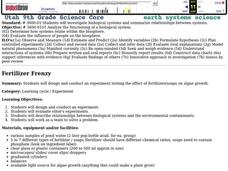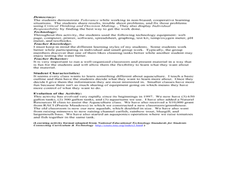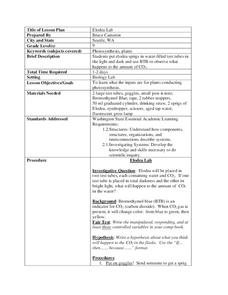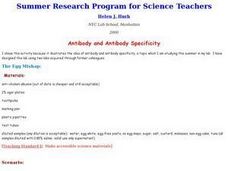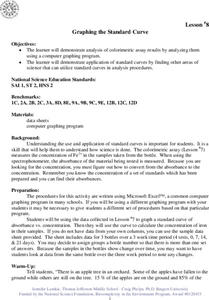Curated OER
Review Game
Students of all ages and subjects can participate in this review game. They are given a note card with a question or problem. The game is over when students have no more questions to answer.
Curated OER
Follow the Water Cycle
Students explore the stages in the water cycle, evaporation, condensation, and precipitation. They hypothesize about the source of rain and search for forms of water on Earth.
Curated OER
Fertilizer Frenzy
Ninth graders design and conduct an experiment. They evaluate other's experiments. Students describe relationships between biological systems and the environmental contaminants. They work as a team to solve a problem.
Curated OER
Biodegradable Plastics
Learners prepare a type of biodegradable plastic. They design method(s) to compare its properties with some common plastics that are readily available in the market. They later advance to identifying variables in an experiment and fair...
Curated OER
Water Quality Monitoring
Students comprehend the four parameters of water quality. They perform tests for salinity, dissolved oxygen, pH and clarity or turbidity. Students comprehend why scientists and environmental managers monitor water uality and aquatic...
Curated OER
You are the Microbiologist
In this lesson plan, students demonstrate comprehension of basic lab techniques by properly using these techniques in preparing a laboratory investigation, demonstrate synthesis of prior lab experiences by solving a new problem using...
Curated OER
Swinging Electrons
Students illustrate paramagnetic and diamagnetic differences due to the unfilled and filled valence shells. They prepare saturated solutions and place into test tubes.
Curated OER
Aquaculture Production in the Classroom
High schoolers study the basics of aquaculture and how to successfully raise aquatic plants and animals. In this water lesson students perform water quality tests on fish tanks, record and graph their results.
Curated OER
Where Do Green Plants Get Energy?
Fourth graders realize that plants need light, water, and carbon dioxide to carry out photosynthesis. They participate in groups of 4 to plant (with materials provided) a test group of beans to compare to the control group, write a...
Curated OER
Comparative Stream Quality
Learners examine water quality on a nearby stream. They collect water samples and test for various factors, including any contamination from the treatment plant, and present their information in a Powerpoint presentation.
Curated OER
How Can Gel-electrophoresis Help in the Identification of a Dna Sample?
High schoolers investigate the principles of gel electrophoresis and DNA testing. They watch and discuss a PowerPoint presentation, and solve a DNA mystery using the information they learned from the presentation.
Curated OER
Observing Popcorn
Fifth graders discover the process of boiling water and how it is part of the changing of states of matter. They observe a kernel of popcorn pop in a test tube with water and take notes of how the water changes to the form of a gas....
Curated OER
Elodea Lab
Students observe the changes between elodea leaves placed in darkness and light. In this life science lesson, students experiment to find evidence of photosynthesis in elodea leaves. Students use indicators to detect the presences of...
Curated OER
Volumw Measurement, English System
Eighth graders biew each volume container and discuss where they have seen them in their home, and how they have seen them used. They explore the different names of volume sizes and their equivalents towards one another. Students...
Curated OER
Hey, Cuz!
Third graders examine the relationships between rhythm and math, tone color and science, form and geography, melody and art, and harmony and social studies. Why, they are like cousins! Students, in groups, present projects demonstrating...
Curated OER
Antibody and Antibody Specificity The Egg Mishap
Students investigate a set of foods to find the presence of eggs after designing an experiment that will complete the test. They complete a test and discuss antibody-antigen specificity.
Curated OER
Lotic Environment Lesson Plans
Learners create and conduct experiments on a "classroom river habitat." They manipulate the biotic and abiotic factors so that they are able to compare an artificially prepared river model to a naturally occurring lotic ecosystem.
Curated OER
Graphing the Standard Curve
Srudents demonstrate analysis of colorimetric assay results by analyzing them using a computer graphing program and demonstrate application of standard curves by finding other areas of science that can utilize standard curves in analysis...
Curated OER
Balloon Lungs
Students study the function of lungs. In this lung function lesson, students complete an experiment using balloons to study the way lungs work. Students study a diagram of their lungs and make a hypothesis for their lung capacity...
Curated OER
Demonstrating That Light is Dissipated as Chlorophyll a Fluoresces
Young scholars examine the concepts of light and chlorophyll. They participate in an experiment in which the chlorophyll shows as a red ring on the test tube. They answer discussion questions to end the lesson plan.
Curated OER
Soil Permeability & Texture
Pupils investigate types of soil to test their water permeability. They collect soil samples, make predictions, conduct the experiment, and answer conclusion questions.
Curated OER
Sustainable Forestry
Middle schoolers explore sustainable forestry and its practices. They take a pretest and discuss concerns of sustainable forestry. Working in groups, they prepare questions to interview one anohter about their views of sustainable forestry.
Curated OER
LearningCheck State Proactice Exams Item Banks
Learners examine state practice test exams questions. In this secondary mathematics exam, students receive instructions for downloading state practice exams, using the test item banks with the TI-Navigator system, and view sample exam...
Curated OER
Dishing the Dirt Part 1
Students create a soil center on their school grounds. They begin to write in their science journals. They participate in an experiment that helps the community begin their own gardens.




